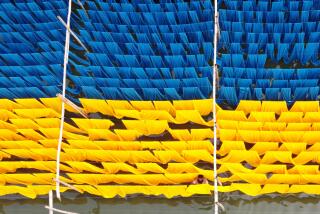Hot? You can cool down by suiting up in this high-tech fabric
- Share via
Just in time for scientists to declare 2016 the hottest year on record, scientists at Stanford University have developed a material that could make the coolest clothes ever — shirts and pants that block the sun’s warming rays while venting body heat more efficiently than cotton or other conventional fabrics.
When the high-tech fabric was draped around a device that mimicked the response of human skin on a hot day, the temperature of the artificial skin rose by only 0.8 degrees Celsius. That’s far less than the 3.5-degree rise when the device was cloaked in cotton or the 2.9-degree increase when clothed in commercially available polyethylene, the stuff that so much athletic wear is made of.
If you were wearing a shirt and hat made of the stuff, it would feel like being shirtless and hatless while standing under a shade tree.
The new fabric, a nanoporous form of polyethylene, and its futuristic cooling properties were described Thursday in the journal Science.
The widespread use of such fabric would not only inaugurate a new era of “personalized cooling,” MIT nanoengineer Svetlana V. Boriskina wrote in an essay that accompanied the study, but it could also pave the way for energy savings by reducing the world’s use of air conditioning.
One day, the material could be used in the construction of tents, buildings and vehicles, Boriskina wrote. If it allowed people to raise the temperature on their air conditioning thermostats, the energy required to cool a building might fall by as much as 45%, Boriskina estimated.
How does a piece of cloth do all that? By scattering specific wavelengths of light in the same fashion that makes the sky appear blue, and by using the same principles that allow the Saharan silver ant to stay cool in the torrid heat of a desert afternoon.
We humans can put on a cotton shirt that protects our skin from the heat of the beating sun. But as it does so, it also traps body heat inside the garment.
The nanoporous polyethylene fabric offers a solution to this problem.
At normal skin temperatures, much of the heat that radiates off our bodies is in the infrared portion of the light spectrum. In laboratory tests, cotton permitted only 1.5% of these longer infrared wavelengths to pass through. (The rest was absorbed by the fabric itself or reflected back onto skin.)
What’s needed is a fabric that’s “transparent” to this infrared radiation but is “opaque” to wavelengths of visible light. That way, the fabric will scatter the visible light so that human eyes will see it, just like molecules in the atmosphere scatter the short wavelengths of blue light and make the sky look blue, Boriskina explained.
Po-Chun Hsu and his colleagues at Stanford found a fabric in the sweet spot. They tested a polyethylene material with pores that measured 50 to 1,000 nanometers across. That spacing allows the passage of infrared radiation, including the heat emitted by human skin. But it still causes sunlight to scatter and reflect upon contact with the material’s surface.
Regular, commercially available polyethylene performed as well as the nanoporous polyethylene in allowing infrared waves to pass through. But it only reflected 20% of visible light. The nanopolyethylene fabric reflected 99% of visible light, the Stanford team reported.
Something similar already exists in nature, in the bodies of Saharan silver ants. These insects rely on extremely fine hairs to scatter sunlight and prevent that heat from being absorbed, while still allowing body heat in the infrared portion of the spectrum to escape. Without their silvery hairs, the ants’ body temperature would be significantly higher, previous research has shown.
If you’re ready to overhaul your wardrobe, Boriskina advises you to cool your heels.
“Much remains to be done to bring the radiative cooling technology to the clothing market,” she wrote. Finely woven fibers that can be produced by more conventional means might do just as well, she noted.
And without further research, our penchant for outfitting ourselves in colorful fabrics could spoil the intended cooling effect. Researchers will have to explore and synthesize dyes and pigments that, like nanoporous polythylene, are transparent to infra-red wavelengths, Boriskina wrote.
Follow me on Twitter @LATMelissaHealy and “like” Los Angeles Times Science & Health on Facebook.
MORE IN SCIENCE
Experimental drug reduces protein clumps and slows memory loss in early Alzheimer’s
Pediatricians urge states to get tough on parents who don’t want to vaccinate their kids
3.2 million years after her death, autopsy reveals Lucy probably died after falling from a tree







